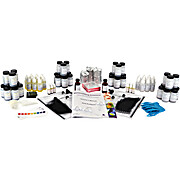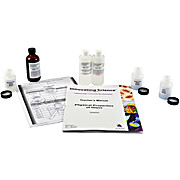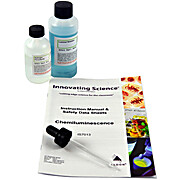Innovating Science Lab Chemistry Kits
-
Kit Soil Analysis Earth Science
Innovating ScienceSoil composition has been a keystone experiment in earth science classrooms for many years. Our soil analysis kit will teach students the skills needed to properly conduct soil composition tests as well as allow them to collect and evaluate local soil samples. By bringing in local soil samples the…
-
Kit Determination Of The Molecular Mass Of Liquid Ap Chemistry
Innovating ScienceA volatile liquid is placed in a test tube and the tube is closed with a stopper with a hole in it. The test tube is placed in a hot water bath. The liquid vaporizes and excess vapors escape through the hole. The tube is then placed in an ice bath to quickly cool the vapor and cause it to condense.…
-
Kit Genetics Of Blood Types
Innovating ScienceBlood type, an inherited characteristic, has use in everything from forensic investigations to medical procedures. In this activity, students will learn about the genetics that determine blood type and the possible inheritance patterns and how they express themselves. Students will use Innovating…
-
Kit Fractional Distillation Sm Grp
Innovating ScienceCrude oil is a complex mixture of many useful hydrocarbons such as gasoline, kerosene, butane, and motor oil. In order to be of use, these hydrocarbons must first be separated from each other. In this activity, students will complete a fractional distillation experiment to simulate the…
-
Kit Abo/Rh Blood Typing Lab
Innovating ScienceThis activity provides the most procedurally accurate simulation of the blood typing technique available. Students test and determine the ABO/Rh blood types of four different simulated blood samples. Using Innovating Science’s new simulated blood, the students combine blood samples and antisera,…
-
Kit Oil Spill Clean Up
Innovating ScienceIn this activity, students will compare two methods of oil spill cleanup: biological and physical. Applying both a special blend of oil degrading microbes and a hydrocarbon encapsulating polymer to oil and examining the results, students will draw conclusions with regard to the effectiveness of…
-
Kit Structure & Conc In Acid/Base Titrations Ap Lab#14
Innovating ScienceStudents will conduct a series of acid-base titrations and determine the concentrations of two unknowns. They will create a procedure to collect quantitative titration data using a buret and pH meter. Using titration data that they collected, they will determine the concentration of each unknown.…
-
Kit Production Of Biodiesel Small Group Learning
Innovating ScienceIn this activity, students will be performing a two-phase process to produce small batches of crude biodiesel. The crude biodiesel produced is of sufficient quality for use in the demonstration of the burning qualities of both biodiesel and vegetable oil. Included is an optional small-scale…
-
Kit Solid Fuel Chemical Demonstration Kit
Innovating ScienceTwo solutions are poured together in a beaker and form a gel. The gel can be ignited with a match. Commercially this gel is sold as Sterno®. Aligned to the Next Generation Science Standards (NGSS)* Disciplinary Core Ideas: PS1.A; PS1.B Performance Expectations: MS-PS1-2; HS-PS1-2 Cross Cutting…
-
Kit Replacement Urine For Is3008
Innovating ScienceRefill Kit Includes: 4 Simulated Urine Samples, 250mL each Patient X Patient Y Patient Z Control DOT Info: Small quantity exemption 173.4 THIS PACKAGE CONFORMS TO 49 CFR 173.4 for domestic highway or rail transport only
-
Kit Crystal Growing Kit
Innovating ScienceThis kit offers a chance for students to view the formation of colorful and unique shaped crystals. Over the period of a week, students will be able to observe natural formation of crystals. This kit also provides teachers with the opportunity to discuss the formation of crystals and how they play…
-
Kit Negative Coefficient Of Solub- Ility Chemical Demo
Innovating ScienceExplain how there are exceptions to the rules of chemistry. Heat a solution and watch it form a precipitate. Watch it go back into solution as it cools. Aligned to the Next Generation Science Standards (NGSS)* Disciplinary Core Ideas: PS1.A; PS1.B Performance Expectations: MS-PS1-2 Cross Cutting…
-
Kit A Safer Flame Test: Identifi- Cation Of Metal Lab Activity
Innovating ScienceThe flame test is an analytical technique often used for the identification of certain elements, primarily metal ions. The color of the flame is observed and the spectra of light emitted from the flame is viewed through a spectroscope. Traditionally, this test poses safety concerns for students in…
-
Kit Forensic Case Study: Murder At Eagle Nest Harbor Refill
Innovating ScienceRefill Kit Includes: 1 x 10 mL Crime Scene: Blood Evidence 1 x 10 mL Suspect 1: Blood Evidence 1 x 10 mL Suspect 2: Blood Evidence 1 x 10 mL Suspect 3: Blood Evidence 1 x 10 mL Suspect 4: Blood Evidence 1 x 10 mL Suspect 5: Blood Evidence 3 x 10 mL Anti-A Antiserum 3 x 10 mL Anti-B Antiserum 3 x 10…
-
Kit Forensic Chemistry Of Carbon Fingerprinting
Innovating ScienceLearn to identify and classify different types of fingerprints. Students will learn how to identify different types of fingerprints and distinguishing characteristics, as well as dusting for fingerprints, the oldest and most commonly used method of fingerprint detection. Kit contains enough…
-
Kit Chemistry - Investigating Your World Acs Kit
Innovating ScienceThis series of activities, developed by the American Chemical Society through grants from the National Science Foundation and National Institutes of Health, is comprised of four lessons that investigate chemical changes. Using the instruction manual obtained from the American Chemical Society’s…
-
Kit Photosynthesis The Hill Reaction
Innovating ScienceThe ability to convert light energy into usable chemical energy (photosynthesis) makes life possible. The process of photosynthesis can be broken down into two parts known as light and dark cycles. The activities in this kit focus on understanding the function of the light cycle by running…
-
Kit Complete Set/16 New Ap Chem
Innovating ScienceThe complete set of Innovating Science 16 AP Chemistry Kits is available! Kits Included; IS8101 Lab #1: Effect of Concentration on Transmitted Light IS8102 Lab #2: Beer’s Law – Mass percent of Copper in Brass IS8103 Lab #3: What Makes Water Hard? IS8104 Lab #4: Acid in Fruit Juices and Soft Drinks…
-
Kit Physical Properties Of Glass
Innovating ScienceOften times, during a criminal investigation, police and crime scene investigators must use all available tools and pieces of evidence to work backwards and create the most likely scenario as to what might have occurred. Different types of evidence provide different pieces to the puzzle. Learn…
-
Kit Electrophoresis: Agarose Separation Of Dyes
Innovating ScienceIntroduce your students to this valuable separation science in a safe and colorful manner. Unlike DNA and other molecules which cannot be seen during electrophoresis, this activity uses dyes that can be observed during the actual procedure, providing visual reinforcement of the forces driving…
-
Kit Seed Germination And Plant Structure
Innovating ScienceDesigned for young elementary students to help them examine and understand the needs of plants for growth and survival. This kit contains materials for 15 groups of two to dissect and germinate seeds, and compare their plant’s growth to other types of plants grown in the classroom. Aligned to the…
-
Kit Determiniation Of Salinity
Innovating ScienceThis kit has been designed to allow the analyst to perform a very simple titration to determine the salinity of their water sample. The titration uses an easily identifiable color transition to indicate the end of the analysis. This kit contains enough materials to perform 40 tests. Aligned to the…
-
Kit Determination Of Properties Of Buffer Sol Ap Chemistry
Innovating ScienceIn this experiment, you will prepare three buffer solutions having different pH values and show that the pH of these solutions does not change significantly when small amounts of acids and bases are added. You will also show that when the same amounts of acids and bases are added to water and to a…
-
Kit Properties Of Aspirin Small Gr
Innovating ScienceAspirin is to this day the most widely used painkiller and largest selling non-prescription medicine in the world. Learn about the history of the development acetylsalicylic acid (aspirin) and test the performance of several different types of aspirin. Students will examine the solubility of…
-
Kit Electrophoresis And Dna Fragment Length Determination
Innovating ScienceRestriction enzymes are enzymes that are capable to cleaving, or cutting, DNA molecules in very specific spots based on the DNA molecule’s sequence of bases. Their discovery and isolation in the latter half of the 20th century provided scientists with an invaluable tool and rapidly expanded in the…
-
Kit Determination Of Cholesterol Using Simulated Blood
Innovating ScienceCholesterol levels can have a major impact on your health and your risk of heart disease. In this activity, students will measure the total cholesterol level for four patients using test strips and simulated blood. After analyzing their results and the lifestyles of each patient, students will…
-
Kit Chemiluminescence Chemical Demonstration Kit
Innovating ScienceExplain and view chemiluminescence. Observe how luminol is converted to an excited state in the presence of an oxidizer such as hydrogen peroxide. As the excited state molecule decays or returns to the ground state, energy is produced as light. Aligned to the Next Generation Science Standards…
-
Kit Glow It Up Acs Kit
Innovating ScienceThis lesson, developed by the American Chemical Society through grants from the National Science Foundation and National Institutes of Health, explores chemical reactions that release energy in the form of light, know as chemiluminescence. Teachers begin with a demonstration that uses a luminol…
-
Kit Effect Of Salinity On Seawater
Innovating ScienceThe world’s ocean system contain a dynamic thermohaline current system that is responsible for many aspects of our environment. The experiments in this kit have been designed to help visualize the impact solutions of different density have on each other when mixed. Students will measure the…
-
Ferrofluid 50Ml
Innovating ScienceFerrofluid is a colloidal liquid made of particles less than 10 nanometers in diameter. When exposed to to a magnetic field, the nanoparticles form regular patterns of peaks and valleys. You can demonstrate magnetic fields for your students in a very visual way. Included: 50mL Ferrofluid WARNING:…
-
Lab Pillows Pk/18 4" X 14" X 1"
Innovating ScienceEach 4? x 14? x 1? lab pillow absorbs 0.22 gal(750 ml) of solvent. Not to be used on hydrofluoric acid. 18 Lab Pillows DOT Info: Non-regulated
-
Universal Ind. Ph Color Chart Pk/30
Innovating ScienceUniversal indicator color chart cards are used to determine the pH of a solution. These handy smaller chart cards display the colors and pH values an indicator would create for each pH unit from 3 to 10. The charts are also available as a laminated 8 1/2? x 11? Color Chart (IS5097) and 8 1/2? x 11?…






























